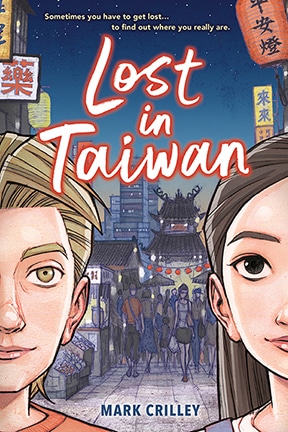
Lost in Taiwan
(LBInk/Little, Brown and Company)
- Fiction
- Set in Taiwan
Key words: Contemporary, identity, empathy, exploration
THIS WASN’T PAUL’S IDEA.
The last thing he’s interested in is exploring new countries or experiencing anything that might be described as “cultural enrichment.” But like it or not, he’s stuck with his brother, Theo, for two weeks in Taiwan, a place that—while fascinating to Theo—holds no interest to Paul at all.
While on a short trip to a local electronics store, Paul becomes hopelessly lost in Taiwan’s twisting, narrow streets, and he has no choice but to explore this new environment in his quest to find his way back to Theo’s apartment.
In an unfamiliar place with no friends—and no GPS!—there’s no telling what adventures he could happen upon. And who knows? Maybe it turns out he has friends in Taiwan, after all.
So much of my life is about avoiding failure. Avoiding it by…not even trying to do anything in the first place.
—Lost in Taiwan (p. 234)
Appropriate for Grades: 6–9
Best for Grades: 6–7
Introduction to the Book
Lost in Taiwan takes readers on a whip-fast ride from the heart of Taipei, Taiwan, into its rural outskirts. With illustrations that bring to life the city streets and alleyways, this book serves as a great introduction to the tourist experience of Taiwan; the steaming dumplings and cups of tea; the architecture; and the generous, welcoming nature of the culture. It is the kind of book that will excite students to explore more about the country and maybe even inspire a desire to visit.
Since the protagonist, Paul, is a newcomer with no background knowledge of Taiwan, readers are also able to leap right into this story without needing any background knowledge regarding the language or the geopolitics of Taiwan. The story does not delve into the complexities of the region, and when a word written or spoken in Mandarin is used, the characters help the reader make sense of it.
Best Matched Curricular Units
- Empathy for Strangers (Humanities)
- Map Skills (Geography)
- Introduction to Taiwan (World Studies)
Essential Questions
- How can we best explore the world?
- What kinds of friendships add value to our lives?
- How can language bridge cultures?
Suggested Activities
Cover Predictions. Before reading the book, ask the students to take a close look at the cover. Students might raise questions about the story (for example: What is the black stove-type thing? What happens inside the building? How old is the tree? Are the boy and girl siblings or friends or something else?). After reading the book, discuss which of those questions have been answered.
Foreshadowing. The book begins with nine pages of illustrations that foreshadow the storyline. In addition, every chapter starts with an illustration on the opening page (for example, a scooter to begin chapter 2). Students can predict how each chapter illustration will connect to the plot. After they finish reading the chapter, discuss which predictions were correct, and explore why students believe the author chose that particular object to illustrate the chapter. Would they have selected a different “foreshadowing object” if they had illustrated the book?
Research the Irony. Peijing says she dreams of opening an English-style teahouse in Taiwan, a dream with incredible historical irony. Research the origins of tea in England, how the English got a taste for it, and how it shaped the British empire’s colonial rule, specifically in China. Can students see the irony in an English-style teahouse opening in Taiwan? Can the students create any similar examples of irony for a young Taiwanese dreamer (or a young dreamer from another cultural background)?
Suggested Discussion/Writing Prompts
To Translate or Not to Translate. Throughout the book, the author chooses to use the traditional Chinese script when a character speaks in Mandarin. He could have chosen to translate their words and then indicate the language was spoken in Mandarin by altering the script (for example, by using a different font, color or italics), but he does not. Why would the author elect to keep the words untranslated for a readership who will most likely be unable to read them? How does it benefit the story? If the technology is available, choose a page with Chinese script and translate it. How does having the translation available alter the reader’s experience?
Coca-Cola Symbolism. On pp. 132–133, we learn how Coca-Cola is translated into Chinese script for use in Taiwanese advertising. The author illustrates a can of Coca-Cola in the final two-page spread of the entire book (pp. 244–245). What do students believe is the symbolism here? Consider the prominence of the character 樂 (le), meaning happiness, as well as the company’s country of origin.
A good reference for further study and lesson plans is Centering Taiwan in Global Asia, a K-14 Curriculum Resource About Taiwan (https://centeringtaiwan.pitt.edu/).
Author: Josh Foster, Educator and Learner
2025
